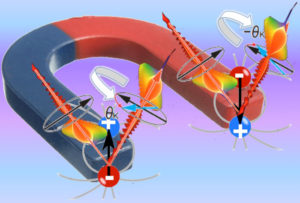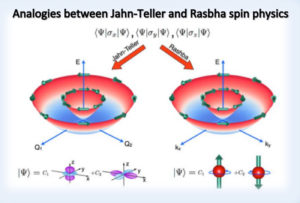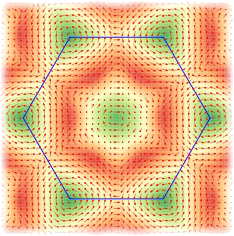
RESEARCH
Summary of Research Activity
-

The switching of the Kerr rotation is achieved when switching both P and M in a perovkiste metal-organic framework.
Electric Magneto-Optical Kerr Effect.Very recently, we started to explore the effect of the coupling of electric and magnetic ordering to the magneto-optical Kerr effect. Our studies show that, in specific conditions, the Kerr rotation angle can be tuned acting not only on M (magnetization) but also on the electric polarization P. This indicates the interesting possibility of controlling the Kerr rotation angle by either P or M, or by both of them, and it introduces novel switching properties. This interesting property of non-centrosymmetric magnetic materials suggests an electrical tunability of the Magneto-Optical Kerr Effect. Such a tuning could be realized in a variety of materials, ranging from multiferroics and/or magnetoelectrics, non-polar ferromagnets, polar antiferromagnets, polar metals, etc. Although our preliminary conclusions were derived for a complex hybrid perovskite system, they should be generalized to other material systems. These results have been published in Journal of American Chemical Society R and presented as invited talk at EMRS 2018 (Fall meeting).
-

The mean values of the Pauli matrices on spinor-like states may have a dual interpretation depending on the relevant space of the physical system. In either case, they can be visualized as 3D vectors, representing a “texture”.
The power of analogies. In general, reasoning by analogies is a powerful way of developing physical theories.R We studied the intimate connection between the Jahn-Teller physics and the Rasbha spin-physics.R In this work we show an important formal analogy between widely different problems, namely, the Jahn-Teller distortion in molecular physics and the Rashba/Dresselhaus spin splitting in condensed matter physics. Although the two phenomena differ in their physical context, we establish a formal mathematical mapping between them, explore their conceptual features, and search for rispective counterparts. As a result, one can define, in the Jahn-Teller theory, the orbital texture, as the counterpart of the spin texture in Rashba physics. In both cases, textures are represented by three-dimensional vectors in the appropriate space. This, in turn, allows us to introduce an effective representation of the orbital polarization associated with a constant energy contour in parameter space of the Jahn-Teller problem. We propose time-resolved resonant inelastic x-ray scattering experiments as a possible way of experimentally detecting the orbital texture. Importantly, we draw analogies between other Rashba-related spin-splitting phenomena – such as the linear Dresselhaus effect – and JT problems with specific symmetries, showing complex spin and orbital texture. This work has been discussed as invited talk in XXIII International Symposium on the Jahn-Teller Effect.R Figures in this work has been selected for the Cover Image of the J. Quantum Chem.R
References:
, , , , , . Int. J. Quantum Chem. 2016, 116, 1442–1450. DOI: 10.1002/qua.25209
- Two dimensional materials. Graphene-like materialsR; dipole ordering and connection to valleytronics.R,R, R For example, we discuss the emerging valley-dependent properties and
the coupling of spin and valley physics, which arise from the loss of inversion symmetry due to dipole ordering, and explore the interplay between electric polarization and Rashba spin-splitting phenomena. We show that valley-related properties originate mainly from the binary nature of AB monolayers, while the Rashba spin-texture developing around valleys is fully controllable and switchable by reversing the ferroelectric polarization.R,
